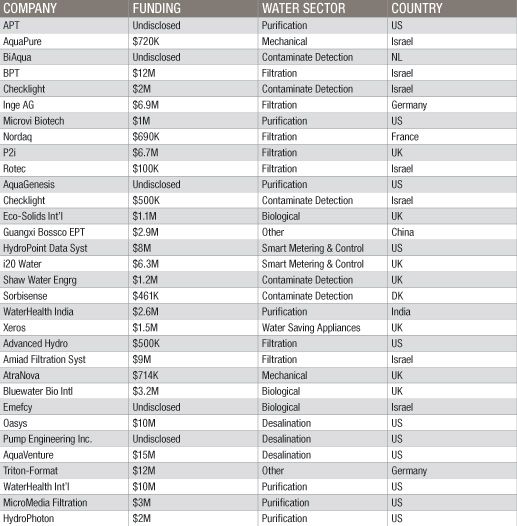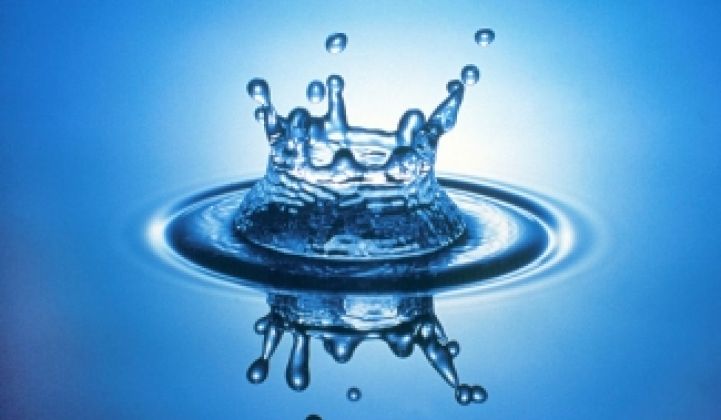APTwater's Upcoming Investment Round
APTwater is a ten year old firm making water treatment technology that removes agricultural nitrates (fertilizer) and difficult to treat contaminants from ground water and other water sources.
APTwater was venture firm Kleiner Perkins' initial water investment. Although the investment cannot be found on the KP website, the APT website lists a "multimillion dollar investment from investors including Seacor Holdings, Miller Environmental Group, Teijin Limited, XPV Capital, and Kleiner Perkins." (XPV Capital, uniquely, is a VC investor solely focused on the water sector. Their site is a good source for facts on water issues).
APT is now out looking for their Round B according to an inside source. KP and XPV will invest but they are seeking strategic investors who could add value for international market expansion, amongst other things. The source said that Kleiner wants to scale the company and go IPO. As of last July, APTwater had already brought in $10.5 million in equity, according to VentureBeat.
Ray Lane, a partner at KP has said that every year the partners at KP list areas they'd like to consider investing in and water always make the list. The problem is "You have to kiss a lot of frogs" to find the right investment in water.
According to their website, APTwater’s process technologies are based on Advanced Oxidation Process chemistry which produces the hydroxyl radical, the most powerful oxidant available for water treatment, capable of destroying a wide range of organic chemicals via an oxidative chain-reaction. Depending on the treatment objectives and contaminants, the oxidation process may destroy compounds to harmless intermediaries for treatment by another process, or be oxidized completely to dissolved CO2 and oxygen enriched H2O. APTwater claims its process produces zero waste water (compare that to energy and water intensive reverse osmosis).
An investor colleague informs me that Advanced Oxidation is the “new rage” in the water world. It is basically a chemical treatment process that removes organics and inorganics from waste water through oxidation. Contaminants are oxidized through a number of inputs (ozone, hydrogen peroxide oxygen, air) and a number of sequential stages/steps (dosing, oxidation, settling, etc). The IP comes in on the system engineering side which maximizes efficiency, decreases costs, and minimizes footprint allowing you to beat out incumbents with outdated systems or less effective/efficient AOP processes. Purfresh has been promoting a ozone purification system for years--many bottled water vendors use it to sterilize their bottles and a good portion of the bag lettuce you eat has been run through its ozone system as well.
APTwater looks to address the full scope of water usage - drinking water, environmental remediation, process water, and industrial wastewater markets. The firm claims that APTwater’s Environmental Remediation systems have been installed at more than 120 remediation sites around the world. Wastewater can also serve as a source of materials: Ostara Nutrient Recovery Technologies and Oberon have concoted systems that extract solids from purification streams and repackage them as fertilizer or animal feed.
Venture Capital Investment in Water
Opportunities in the water market seem obvious. The water market is:
- Huge and expanding
- In a crisis that cries out for innovation and efficiency
- Not experiencing a bubble
- Deeply enmeshed with energy usage
- Needing a variety of new technology approaches
VC lore has it that you can't make money in water; it's too long a design cycle, too regulated and too fragmented a market. The main players in water are large conglomerates like General Electric, Veolia, Siemens that can undertake multi-year contracts. The best shot for a VC investment, say some, lay in building up a company to sell it to GE or IBM, another company with a big interest in water.
Flying in the face of this theory is the fact that Energy Recovery had one of the few recent and successful Greentech IPOs last year. And it turns out that VCs are indeed investing in water across a variety of water sectors.
Here's a quick list of of the more than $150 million in water investments in 2009. Note that while Israel has its share of water startups, U.S. VCs seem to be waking up to the water market as well. Watch out for a surge in water investments in 2010 and 2011.

Some Venture Capitalist Views on Water
Peter Nieh, a partner at VC investment firm Lightspeed Venture Partners said via email, ”Water is an alluring market because the need is clearly there and the opportunity is large. [There is] some great technology out there. The issue for us is that economically attractive distribution is hard to achieve because the market is so fragmented.”
“[I] definitely agree that water is a challenging sector... and as such, it's sort of the Rodney Dangerfield of cleantech investments,” observed Steve Vassallo of Foundation Capital.” “That said, we have invested in this area (PurFresh was one of Foundation’s first cleantech investments) and are actively looking for opportunities to invest in capital efficient businesses that address the needs of commercial, industrial, and agricultural users of water.”
Will Coleman of VC firm Mohr Davidow Ventures is also looking carefully at water deals and states. “As for water, yes, we have had an interest in water for quite a while, but it has always been hard to identity venture opportunities in the space. The market is huge. The "water" market in the US alone is over $100 billion annually, but a significant portion of that is in earthworks and pipes. When you slice it a little finer you find that a third of the market is driven by residential, where the cost of water to the end customer is really not a driver.”
Rachel Sheinbein was a water expert at Intel, dealing with the flood of waste-water produced in the fabrication of Intel’s semiconductor products. Today she’s an associate at CMEA Ventures and part of the investment firm's Energy & Materials team. She vets the VC firm’s cleantech deals but has a particular thirst for water start-ups and states, “I believe there’s an opportunity in water but I haven’t found the investment yet.”
Sheinbein added, “We’re good at materials and membranes,” and, “We would look to get to market through the commercial and industrial space first, as opposed to the conservative municipal water channel.”
Water Crisis
There is already a water crisis in developing nations and in some not-so-developing nations. Additionally, there is a looming water crisis for everyone else on the globe as populations rise, as pollution increases and as climate and weather patterns change.
There are a “scary number” of pollutants in our water supply, said Gayle Pergamit, the CEO and founder of Agua Via, an early stage membrane developer. These pollutants include “natural” poisons like boron and arsenic, nitrogenous wastes from humans and farm animals, and “other goodies” like hydrocodone and estrogen disruptors. “There can be any of 500,000 different interesting and entertaining chemicals in the water supply,” she said.
“Nanotechnology-based water filtration could deliver completely pure water from any source at vastly reduced energy usage and lower total costs,” added Pergamit.
Other firms working on membranes for water applications include the industrial plumbing giant Danfoss, while Novozymes and a startup called Aquaporin are doing similar work. These companies have produced samples and hope to be in the market by this year or next. The challenge, said Aquaporin CEO Peter Jensen to Greentech Media, isn’t so much in creating artificial proteins. It is making the membrane durable.
”The discouraging thing about this is that [VCs] really don’t understand that we (the U.S.) are entering an era of water scarcity (as opposed to large chunks of the rest of the world who are already in the midst of water scarcity),” said Pergamit of AguaVia in an email. “Maybe they don’t buy the concept of climate change – anthropogenic or otherwise. But it also means that they don’t understand aquifer exhaustion and the fact that even if there wasn’t one whit of climate change, we are still going to run out of water.”



